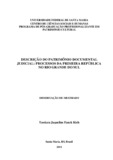| dc.creator | Kich, Tassiara Jaqueline Fanck | |
| dc.date.accessioned | 2011-11-04 | |
| dc.date.available | 2011-11-04 | |
| dc.date.issued | 2011-07-08 | |
| dc.identifier.citation | KICH, Tassiara Jaqueline Fanck. DESCRIPTION OF THE JUDICIAL DOCUMENTARY HERITAGE:
LEGAL PROCESS FROM THE FIRST REPUBLIC IN RIO GRANDE DO SUL. 2011. 110 f. Dissertação (Mestrado em História) - Universidade Federal de Santa Maria, Santa Maria, 2011. | por |
| dc.identifier.uri | http://repositorio.ufsm.br/handle/1/10974 | |
| dc.description.abstract | This study introduces an arrangement and description proposal for lawsuits of custody from the collection of the Archive of the Judicial Court of Rio Grande do Sul. This collection consists of documentary resources that enable social studies, cultural, legal and historical. For
organizing and accessing information, the cases were arranged and described by applying the archival functions according to the needs and specificities of the court files. Considering the Brazilian Standard of Archival Description, were defined and described the description levels base, section, subsection, series and process, which were described as the evidence presented by the Standard. Contemplated, in the arrangement, the deep Judicial Power of Rio Grande do Sul, the 1st and 2nd degree sections, the subsections as document producer Counties all over the State and the series used in the classification procedure of the National Council of Justice. For the process level, was established a model considering the elements the Standard and basic procedural information to the monitoring and location of the files. The proposed description is being applied along the lawsuits representatives of the First Republic (1889-
1930). Among the processes initiated in this period, were randomly selected from statistical calculations, those being described. Analysis of the information described allows relations with facts and social, political and cultural aspects from the historical period considered,
providing the scholars with numerous opportunities for research. The paper presents some of these possibilities of analysis, in addition to the proposed adoption of the model describing the processes in the computerized file from the Judicial Archive. In this regard, the objectives
of defining and implementing the arrangement and description have been achieved, allowing access and research to relevant information contained in court documents. | eng |
| dc.format | application/pdf | por |
| dc.language | por | por |
| dc.publisher | Universidade Federal de Santa Maria | por |
| dc.rights | Acesso Aberto | por |
| dc.subject | Patrimônio documental | por |
| dc.subject | Poder judiciário | por |
| dc.subject | Arranjo | por |
| dc.subject | Descrição | por |
| dc.subject | Documentary heritage | eng |
| dc.subject | Judicial branch | eng |
| dc.subject | Arrangement | eng |
| dc.subject | Description | eng |
| dc.title | Descrição do patrimônio documental judicial:
processos da primeira república no Rio Grande do Sul | por |
| dc.title.alternative | Description of the judicial documentary heritage:
legal process from the first republic in Rio Grande do Sul | eng |
| dc.type | Dissertação | por |
| dc.description.resumo | Este trabalho apresenta uma proposta de arranjo e descrição para processos judiciais de guarda permanente do acervo do Arquivo Judicial do Tribunal de Justiça do Rio Grande do
Sul. Este acervo é composto por fontes documentais que permitem estudos sociais, culturais, jurídicos e históricos. Para organização e acesso às informações, os processos foram
arranjados e descritos, aplicando as funções arquivísticas de acordo com as necessidades e especificidades dos arquivos judiciais. Considerando a Norma Brasileira de Descrição
Arquivística, definiu-se o arranjo dos documentos nos níveis fundo, seção, subseção, série e processo, os quais foram descritos conforme os elementos apresentados pela Norma.
Contemplou-se, no arranjo, o fundo Poder Judiciário do Rio Grande do Sul, as seções 1º e 2º Graus, as subseções como Comarcas produtoras de documentos em todo o Estado, e as séries utilizadas na classificação processual do Conselho Nacional de Justiça. Para o nível processo, estabeleceu-se um modelo considerando os elementos da Norma e as informações processuais fundamentais ao acompanhamento e localização dos autos. A descrição proposta está sendo aplicada em conjunto de processos judiciais representativos da Primeira República (1889-1930). Entre os processos iniciados nesse período, foram selecionados aleatoriamente, a partir
de cálculo estatístico, aqueles que estão sendo descritos. A análise das informações descritas permite relações com fatos e aspectos sociais, políticos e culturais do período histórico
considerado, fornecendo aos estudiosos inúmeras possibilidades de pesquisas. O trabalho apresenta algumas dessas possibilidades de análises, além da proposta de adoção do modelo de descrição dos processos no sistema informatizado do Arquivo Judicial. Nesse sentido, os
objetivos de definição e realização do arranjo e descrição foram alcançados, permitindo o acesso e pesquisa a relevantes informações constantes nos documentos judiciais. | por |
| dc.contributor.advisor1 | Konrad, Glaucia Vieira Ramos | |
| dc.contributor.advisor1Lattes | http://buscatextual.cnpq.br/buscatextual/visualizacv.do?id=K4734320Y7 | por |
| dc.contributor.referee1 | Perez, Carlos Blaya | |
| dc.contributor.referee1Lattes | http://buscatextual.cnpq.br/buscatextual/visualizacv.do?id=K4767398Y4 | por |
| dc.contributor.referee2 | Flores, Daniel | |
| dc.contributor.referee2Lattes | http://buscatextual.cnpq.br/buscatextual/visualizacv.do?id=K4707198D6 | por |
| dc.creator.Lattes | http://buscatextual.cnpq.br/buscatextual/visualizacv.do?id=K4221244E4 | por |
| dc.publisher.country | BR | por |
| dc.publisher.department | História | por |
| dc.publisher.initials | UFSM | por |
| dc.publisher.program | Programa de Pós-Graduação em Patrimônio Cultural | por |
| dc.subject.cnpq | CNPQ::CIENCIAS HUMANAS::HISTORIA | por |


